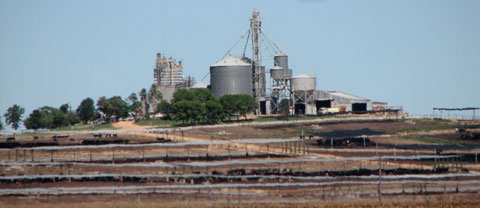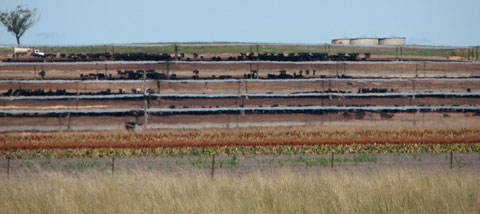Those of you who have read my first book, The Woman on the Mountain, will know I’m a vegetarian. That is just my personal choice: I don’t want to kill another creature, or cause any to be killed for me by others, therefore I won’t eat any. Nor have I, for 36 years now.
Many people aiming at self-sufficiency are not vegetarian, and keep their own chooks or sheep or pigs or cows or whatever they intend to eat – some with small yards are breeding guinea pigs, I read. But they know their animals, care for them, respect them. Those animals live the lives of their domesticated kind until the moment they are killed.
Not so in factory farming.

When I realised what I was driving past, I felt sick.
This is a feedlot, a production plant for cattle to become beef. Here cattle are fed the grain grown on the surrounding plains, watered and given shade. Perhaps they get other growth-helpers or medications, I don’t know.
But that’s all. Bare earth is their world; green is something beyond their confines; it does not signify grass, for that is foreign to them – either underfoot or in their mouths.

OK, while they fatten they aren’t penned too tight to move, like factory hens or pigs, but who would consider this is a ‘life’ for any creature?
To my mind it is merely a long pending death, perpetrated by the inhumanity of corporate greed, which sees these animals as mere production lines, beef-producing machines.
Surely nobody on their corporate boards can have had their fingers sucked clean of warm milk as they try to rear a poddy calf, or been followed about by a bleating, gambolling pet lamb who has inexplicably adopted you.
Feedlots are not the norm in Australia, but most people don’t know or think about what happens to the animals that provide their food.
In my experience, I most respect the lives of those who have made informed choices. Take a look at the Voiceless website.
Hi John,
Thank you very much for that insight into a different purpose of feedlots. I do accept their benefit in this circumstance, and hadn’t known that aspect. We agree it is not the way for cattle to live their lives.
I should add that my dad loved his cattle and his main comment on my place was that it would look better with a few fat Herefords grazing on it!
Best wishes for a wetter year for you and your cattle.
Sharyn
Sharyn
I am a farmer in a drought situation and yes I have raised orphan Joeys, lambs, calves – protected eagles nests, follow strict animal welfare practices and love our country and all the animals that inhabit it.
I am about to send about 180 head of cattle to the Caroona feedlot – and am relieved and grateful that of the opportunity to do so. My much loved cattle will be fed and cared for – not so much in a manner of my choosing as I would much prefer to have continued looking after them myself, but the reality is for them to stay on our farm would mean a slow lingering death through starvation. Feedlots might be confronting to some but their contribution to animal welfare in droughts such as this is immense. Literally millions of cattle are saved from indescribable agony as a result of their presence. It permits cattle too poor to be slaughtered to become so, as well as remove numbers necessary from the landscape in order to provide the remainder and the ever present wildlife a chance of survival. Sharyn, this is (whether you like it or not) truly genuine animal welfare on a an industrial scale.
Hi Peter,
Am also appalled at the blatant rewriting of the law by the NSW Gov. re Caroona & BHP – the one victory we thought we had as inspiration.
The corporate culture is the root issue in so many areas; I am so often saddened/disgusted at the waste and the disconnection it encourages.
That feedlot is near Caroona. I’d assume the meat was for export?
Hi Sharyn,
This is what happens when you take the land away from farmers for mining, destroying the rich history of agriculture in this country. Whether that be beef, poultry or vegetables it is the same result.
The dairy industry that used to be very local is now corporate. The above is where the beef industry is heading (and the poultry industry is already there) and we now import far too much fruit and vegetables from overseas letting fruit rot on the trees here as it’s not worth picking, and now the righteous Caroona Supreme Court decision (in favour of the farmers) has been overturned by a greed-driven Labour Government.
The Sydney Government has a lot to answer for, especially in the Liverpool Plains, the Central West and the Hunter Region.
I eat meat, but I’d be horrified if that is the source. Where is this plant?
P